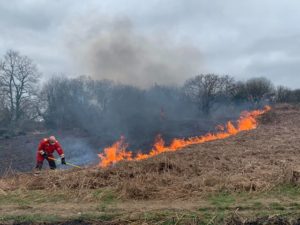As Wales basks in another heatwave, we are being urged not to have barbecues due to the increased fire risk. With this in mind, Confused.com have analysed Fire Authority data to uncover the most fire-prone regions of the UK.
The experts have also issued key advice to help us avoid starting a fire amid these unprecedented temperatures. Extra tips on BBQ fire safety are also available upon request. 😊
- Mid and West Wales is among UK regions most prone to outdoor fires, receiving 55 callouts per 100,000 residents for garden-related blazes over the past decade.
That’s according to new research by Confused.com (Q3, 2022), which analysed outdoor incident report data from Fire and Rescue Services across Great Britain.*
The results:
| # | Fire rescue authority | Garden fire callouts in the past decade (per 100,000 residents) |
| 1 | Bedfordshire | 181 |
| 2 | Inverclyde | 152 |
| 3 | Buckinghamshire | 144 |
| 4 | Surrey | 107 |
| 5 | Hertfordshire | 104 |
| 6 | Northumberland | 103 |
| 7 | Greater London | 101 |
| 8 | Merseyside | 94 |
| 9 | Oxfordshire | 87 |
| 10 | Cornwall and Isles of Scilly | 82 |
| 11 | West Dunbartonshire | 79 |
| 12 | Northamptonshire | 78 |
| =13 | South Yorkshire | 77 |
| =13 | Leicestershire | 77 |
| 15 | Suffolk | 76 |
Mid and West Wales among the top 40
Mid and West Wales places 33rd. The area has seen 54 garden fires per 100,000 people in the last decade. Additionally, the rate of garden fires has increased by 12.85% each year on average since 2012 – the 13th highest of all areas analysed. Mid and West Wales has experienced 54% more fires than North Wales (37), and 80% more than South Wales (30).
The Home counties are the most fire-prone areas of England
With 181 garden fire callouts per 100,000 people in the past decade, Confused.com reveals that Bedfordshire is the worst region for garden fires. In total, 1,230 garden fires were attended to over this period, increasing by 4% each year, on average.
Inverclyde, Scotland comes second, making it the only Scottish area to feature in the top 10. In total, the local fire authority attended 152 garden fire callouts per 100,000 residents in the past decade. This is 93% more fires than West Dunbartonshire (79), the second highest Scottish region, which places 11th overall.
Buckinghamshire, another Home county, places third. In the last decade, authorities in Buckinghamshire had 144 garden fire callouts per 100,000 residents. This is 20% less than Bedfordshire in first place. Garden fires in Buckinghamshire have increased by 11% on average each year in the past 10 years.
Surrey places fourth, witnessing 107 garden fires per 100,000 people over the past decade. When compared to other areas within the top 10, this is just 25% fewer than the total incidents recorded in Buckinghamshire (144 per 100,000). This is also 40% less than the number of fire incidents seen in Bedfordshire in the last 10 years (181 per 100,000).
Hereford and Worcester has seen the biggest increase in garden fires each year
| # | Fire rescue authority | Average % increase in garden fires each year (since 2011) |
| 1 | Hereford and Worcester | +24% |
| 2 | Suffolk | +23% |
| =3 | Tyne and Wear | +21% |
| =3 | Hampshire and Isle of Wight | +21% |
| 5 | Cumbria | +19% |
When it comes to the average percentage increase of garden fires in the past decade, Hereford and Worcester had the highest increase at 24%. The rate of garden fires has also increased by 23% each year on average in Suffolk, and 21% in Tyne and Wear.
Jessica Willock, home insurance expert at Confused.com comments:
“Within recent years, this summer being no exception, we’ve seen unprecedented temperatures – seeing the rate of garden-related fires, and therefore wildfires, rise. In fact, by May this year, the UK had already surpassed the total number of wildfires seen in 2021. However, as most aren’t used to these soaring temperatures, we may not be aware of the dangerous situations we could be putting ourselves in.
“There are every-day precautions that we can therefore take while enjoying the hot weather. This includes:
· Disposing of cigarettes appropriately. Cigarettes that have not been properly extinguished may start a fire on the smallest bits of dry grass.
· If having a barbecue, make sure it’s never left unattended. Barbecues should be on a flat surface, away from any trees, plants or sheds. We also recommend using approved barbecue fuel or fire lighters – never paraffin.
· Ensuring there is no glass on the floor. Glass left on dry grass could start a fire by magnifying the sun. If you see dry grass smouldering, call 999 and report it immediately.
“If a fire gets out of control, we could be at risk of damaging any nearby items or buildings. This may ultimately lead to making a claim on our home insurance. If this does happen, our guide to making a home insurance claim outlines the process to make it as easy and stress-free as possible.”
–
credit to: https://www.boilercentral.com/ for the research for the above article
Help keep news FREE for our readers
Supporting your local community newspaper/online news outlet is crucial now more than ever. If you believe in independent journalism, then consider making a valuable contribution by making a one-time or monthly donation. We operate in rural areas where providing unbiased news can be challenging. Read More About Supporting The West Wales Chronicle






















